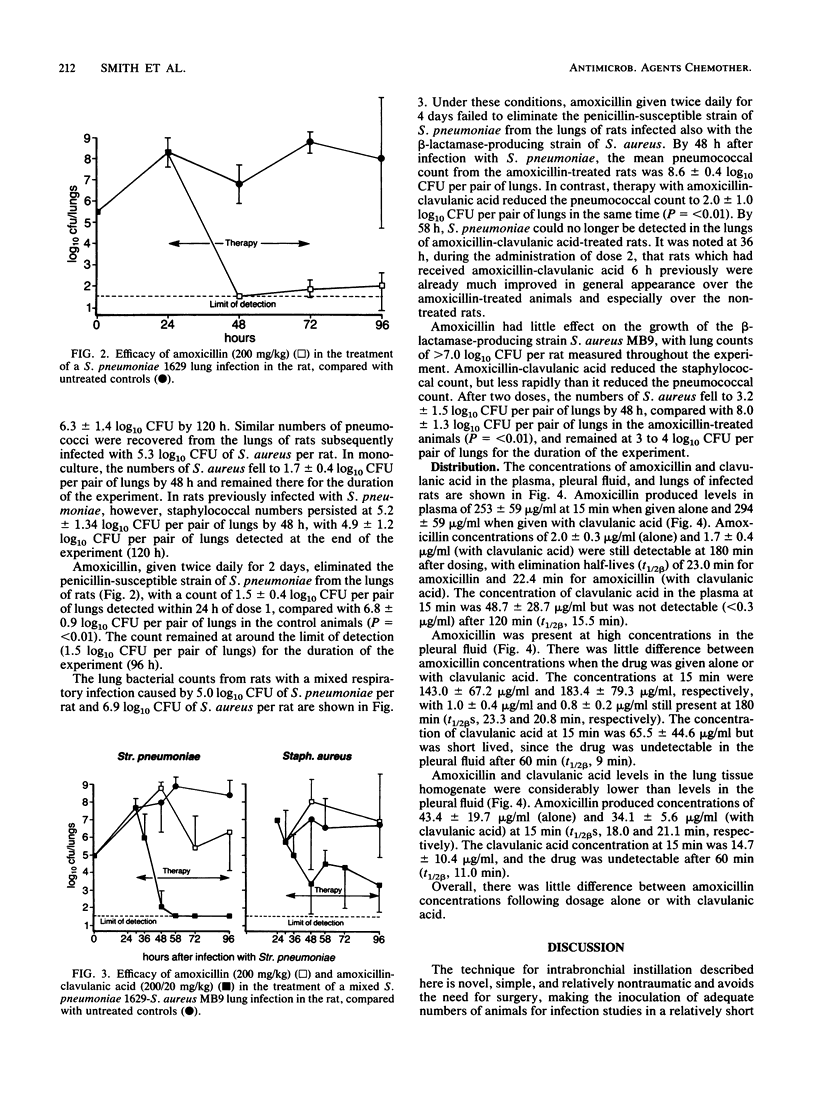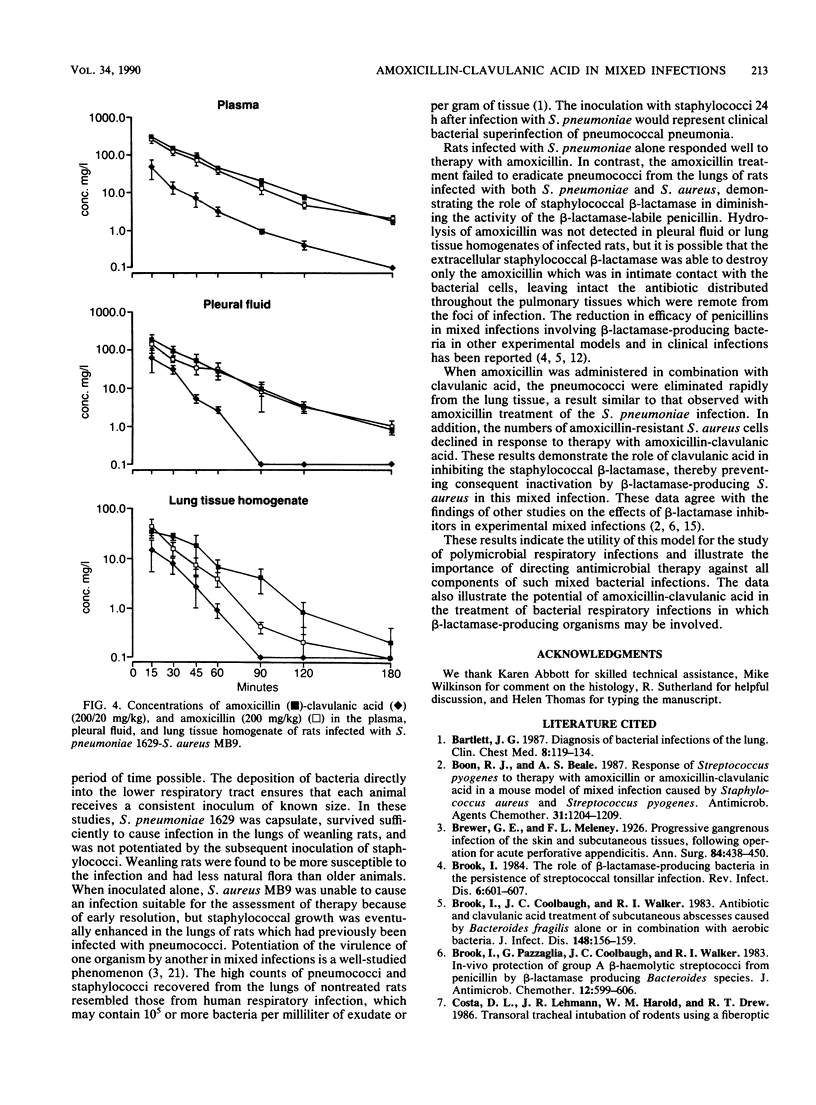Abstract
An experimental respiratory infection caused by Streptococcus pneumoniae was established in weanling rats by intrabronchial instillation. Treatment of this infection with amoxicillin rapidly eliminated the pneumococci from the lung tissue. A beta-lactamase-producing strain of Staphylococcus aureus, when inoculated in a similar manner, did not persist adequately in the lungs long enough to permit a reasonable assessment of the therapy, but staphylococcal survival was extended in the lungs of rats infected 24 h previously with S. pneumoniae. Amoxicillin therapy was relatively ineffective against the pneumococci in this polymicrobial infection and had no effect on the growth of S. aureus. In contrast, amoxicillin-clavulanic acid eliminated the pneumococci from the lung tissue and brought about a reduction in the numbers of staphylococci. The data illustrate the utility of this model for the study of polymicrobial lung infections and demonstrate the role of amoxicillin-clavulanic acid in the treatment of polymicrobial infections involving beta-lactamase-producing bacteria.
Full text
PDF




Selected References
These references are in PubMed. This may not be the complete list of references from this article.
- Bartlett J. G. Diagnosis of bacterial infections of the lung. Clin Chest Med. 1987 Mar;8(1):119–134. [PubMed] [Google Scholar]
- Boon R. J., Beale A. S. Response of Streptococcus pyogenes to therapy with amoxicillin or amoxicillin-clavulanic acid in a mouse model of mixed infection caused by Staphylococcus aureus and Streptococcus pyogenes. Antimicrob Agents Chemother. 1987 Aug;31(8):1204–1209. doi: 10.1128/aac.31.8.1204. [DOI] [PMC free article] [PubMed] [Google Scholar]
- Brewer G. E., Meleney F. L. PROGRESSIVE GANGRENOUS INFECTION OF THE SKIN AND SUBCUTANEOUS TISSUES, FOLLOWING OPERATION FOR ACUTE PERFORATIVE APPENDICITIS: A STUDY IN SYMBIOSIS. Ann Surg. 1926 Sep;84(3):438–450. doi: 10.1097/00000658-192684030-00017. [DOI] [PMC free article] [PubMed] [Google Scholar]
- Brook I., Coolbaugh J. C., Walker R. I. Antibiotic and clavulanic acid treatment of subcutaneous abscesses caused by Bacteroides fragilis alone or in combination with aerobic bacteria. J Infect Dis. 1983 Jul;148(1):156–159. doi: 10.1093/infdis/148.1.156. [DOI] [PubMed] [Google Scholar]
- Brook I., Pazzaglia G., Coolbaugh J. C., Walker R. I. In-vivo protection of group A beta-haemolytic streptococci from penicillin by beta-lactamase-producing Bacteroides species. J Antimicrob Chemother. 1983 Dec;12(6):599–606. doi: 10.1093/jac/12.6.599. [DOI] [PubMed] [Google Scholar]
- Brook I. The role of beta-lactamase-producing bacteria in the persistence of streptococcal tonsillar infection. Rev Infect Dis. 1984 Sep-Oct;6(5):601–607. doi: 10.1093/clinids/6.5.601. [DOI] [PubMed] [Google Scholar]
- Drelichman V., Cushing R. D., Bawdon R. E., Lerner A. M. Possible pseudoresistance of Streptococcus pneumoniae to penicillin G in a patient with a mixed pneumococcus-Staphylococcus aureus pneumonia. Am J Med Sci. 1984 May-Jun;287(3):39–43. doi: 10.1097/00000441-198405000-00014. [DOI] [PubMed] [Google Scholar]
- Goodwin R. A., Opal S. M. Polymicrobial bacteremic pneumonia: report of three cases caused by Staphylococcus aureus and Streptococcus pneumoniae. Am Rev Respir Dis. 1987 Oct;136(4):1005–1006. doi: 10.1164/ajrccm/136.4.1005. [DOI] [PubMed] [Google Scholar]
- Hackman A. S., Wilkins T. D. In vivo protection of Fusobacterium necrophorum from penicillin by Bacteroides fragilis. Antimicrob Agents Chemother. 1975 May;7(5):698–703. doi: 10.1128/aac.7.5.698. [DOI] [PMC free article] [PubMed] [Google Scholar]
- JACKSON D. M., LOWBURY E. J. L., TOPLEY E. Chemotherapy of Streptococcus pyogenes infection of burns. Lancet. 1951 Oct 20;2(6686):705–711. doi: 10.1016/s0140-6736(51)91478-x. [DOI] [PubMed] [Google Scholar]
- Maddocks J. L., May J. R. "Indirect pathogenicity" of penicillinase-producing enterobacteria in chronic bronchial infections. Lancet. 1969 Apr 19;1(7599):793–795. doi: 10.1016/s0140-6736(69)92063-7. [DOI] [PubMed] [Google Scholar]
- Mandell G. L., Hook E. W. Persistence of ampicillin-sensitive Salmonella thompsoni due to fecal penicillinase. Arch Intern Med. 1971 Jan;127(1):137–138. [PubMed] [Google Scholar]
- Pennington J. E. Animal models of pneumonia for evaluation of antimicrobial therapy. J Antimicrob Chemother. 1985 Jul;16(1):1–4. doi: 10.1093/jac/16.1.1. [DOI] [PubMed] [Google Scholar]
- Reading C., Cole M. Clavulanic acid: a beta-lactamase-inhiting beta-lactam from Streptomyces clavuligerus. Antimicrob Agents Chemother. 1977 May;11(5):852–857. doi: 10.1128/aac.11.5.852. [DOI] [PMC free article] [PubMed] [Google Scholar]
- Reading C., Hepburn P. The inhibition of staphylococcal beta-lactamase by clavulanic acid. Biochem J. 1979 Apr 1;179(1):67–76. doi: 10.1042/bj1790067. [DOI] [PMC free article] [PubMed] [Google Scholar]
- Riou B., Richard C., Rimailho A., Auzépy P. Co-infection or early superinfection of pneumococcal pneumonia. Intensive Care Med. 1987;13(5):352–354. doi: 10.1007/BF00255793. [DOI] [PubMed] [Google Scholar]
- Rotstein O. D., Pruett T. L., Simmons R. L. Mechanisms of microbial synergy in polymicrobial surgical infections. Rev Infect Dis. 1985 Mar-Apr;7(2):151–170. doi: 10.1093/clinids/7.2.151. [DOI] [PubMed] [Google Scholar]
- Woodhead M. A., Macfarlane J. T., McCracken J. S., Rose D. H., Finch R. G. Prospective study of the aetiology and outcome of pneumonia in the community. Lancet. 1987 Mar 21;1(8534):671–674. doi: 10.1016/s0140-6736(87)90430-2. [DOI] [PubMed] [Google Scholar]


